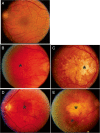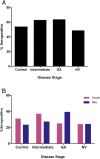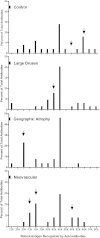Prevalence of anti-retinal autoantibodies in different stages of Age-related macular degeneration
- PMID: 25488058
- PMCID: PMC4269864
- DOI: 10.1186/1471-2415-14-154
Prevalence of anti-retinal autoantibodies in different stages of Age-related macular degeneration
Abstract
Background: Age-related macular degeneration (AMD) is the leading cause of central vision loss in older adults. Anti-retinal autoantibodies (AAbs) have been found in individuals with AMD. The goal of the study was to determine the AAb specificity in different stages of AMD, and determine whether there is a prevalent AAb signature.
Methods: Sera of 134 participants in the Age-related Eye Disease Study were analyzed for anti-retinal AAbs by western blotting. The subjects were classified by diagnostic subgroups based upon their clinical classification: No AMD, Intermediate AMD, and Late AMD - geographic atrophy (GA) and Late AMD - neovascular (NV).
Results: The presence of anti-retinal AAb was detected in 58% patients with Intermediate and Late AMD, and 54% of those with no AMD. AAbs bound to fifteen different retinal antigens. Most individuals had 1 specific AAbs (67%), with the remainder having 2 to 4 different AAbs. Over 40% of patients with Intermediate AMD, and 46% of those with GA had anti-enolase AAbs, compared with 29% of individuals with NV and 29% with no AMD. Different AAbs signatures related to NV as compared to GA and/or Intermediate AMD were distinguished. Anti-40-kDa (10%) and 42-kDa (16%) autoantibodies were associated with Intermediate AMD, while anti-30-kDa AAbs (23%) were primarily present in GA. Anti-32-kDa (12%), 35-kDa (21%), and 60-kDa (8%) AAbs were more frequent in NV AMD.
Conclusions: A unique AAb pattern for each of the disease subgroups was present when AMD progressed from the intermediate to the late forms of severity. Differences in the frequency of specific AAbs between AMD subgroups suggested that they may participate in pathogenicity of AMD. Further studies are necessary to confirm these observations in the larger cohort and individual AMD patients over time.
Figures





References
-
- Kokotas H, Grigoriadou M, Petersen MB. Age-related macular degeneration: genetic and clinical findings. Clin Chem Lab Med. 2010;49(4):601–616. - PubMed
Pre-publication history
-
- The pre-publication history for this paper can be accessed here:http://www.biomedcentral.com/1471-2415/14/154/prepub
Publication types
MeSH terms
Substances
Grants and funding
LinkOut - more resources
Full Text Sources
Other Literature Sources

